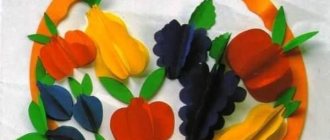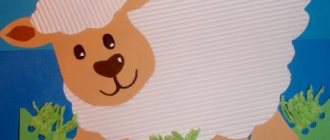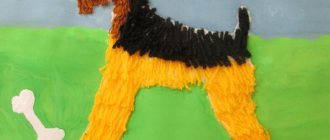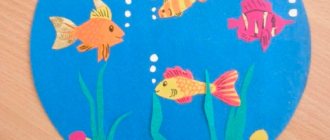Simple craft for kids
You will need: models of circles from multi-colored double-sided sheets or candy wrappers, glue, a prepared fish template, made by yourself or printed on a printer from the Internet.
Children glue overlapping circles of different colors onto the workpiece (torso). Here the guys will be able to act not very carefully, which will not affect the quality of the application and their mood.
Fish in an aquarium
Summary of a lesson on broken appliqué in the senior group on the topic
"Fish in an aquarium."
Goal: To develop the ability to convey in appliqué the image of fish, the features of the shape of the body, tail (cutting out in parts, the development of artistic and creative abilities in children, cultivates patience, perseverance and imagination in children.
Objectives: To introduce the technique of cut appliqué
. Arouse interest in creating a beautiful composition in collaboration with the teacher. Foster independence and accuracy in work. — Summarize children’s knowledge about the underwater world and fish;
— Develop fine motor skills by using familiar cutting techniques (cutting circles from squares, ovals from rectangles, transforming some geometric shapes into others - a square into several triangles);
— To cultivate perseverance, independence, accuracy, to continue to build self-esteem in students;
Materials: pictures of fish, aquarium layout, glue.
board.
Progress of the lesson:
Organizing time.
- Guys, you will find out the topic of our lesson by guessing the riddle.
House made of glass, with water,
There is a small garden in It. And shells here and there, Fishes live in the house. What kind of house is this, children?
Who will answer the riddle... (Aquarium)
Finger gymnastics
The fish swims in the water . Two palms together depict swimming movements.
The fish have fun playing. Clap your hands
Fish, fish, mischief, clap their hands
We want to catch you. The palms are clenched into a fist one by one.
The fish arched its back, a smooth movement with each palm.
I took a bread crumb. Grasping movements with a “pinch”.
The fish wagged its tail, Smooth converging and diverging movements with both hands.
She quickly swam away.
—
Now our fingers are ready to work. I'm sure that with your skills you can make very colorful aquariums. Let's get to work.
Practical activities (
The audio recording
“The Sound of the Sea” plays)
(The children begin to cut out. I check whether all the parts are cut out, whether the structure and location of the parts are correctly conveyed. During independent activities, I give the children advice, if necessary, I provide assistance).
Summary of the lesson.
- Look what a wonderful sea corner we have created for you! All the fish turned out different, bright, interesting.
— Did you like the lesson?
— What was the most interesting?
— Was it difficult? What was the most difficult?
“I’m pleased with everyone’s work today; everyone did their work with great passion and interest!”
Aquarium fish
This task is for the older group of kids, but younger children can also cope with it with the help of adults.
You will need: a white piece of paper or cardboard, a set of multi-colored double-sided paper, glue, yellow and blue paints, a sponge (you can take it for dishes), scissors, ready-made self-adhesive eyes (sold in craft stores).
You can take cardboard or a white piece of paper and paint the background blue and yellow. This way you can differentiate between the sandy bottom and the water in the aquarium. Children can do this entire procedure with a sponge. They will like this kind of work. Next comes the work of preparing the blanks.
Fish can be cut out of colored paper according to a prepared template or sketches. Also do everything with algae, cutting them out of a green leaf, corals from brown or pink, and pebbles can be multi-colored.
To make the composition sparkle with bright colors, you need to distribute the details on the dried cardboard.
Such a fun craft can be placed in any room, and it will cheer up both children and adults.
Step-by-step instructions for making appliques using various techniques
Application using templates
This type is very simple to perform. Typically, gluing template parts onto paper is used in younger groups of kindergartens. Children get initial appliqué experience.
To make fish parts using templates, you must do the following:
- Prepare templates for each part of the fish. To do this, you need to cut out the main elements of the fish: the body, scales, fins and tail from cardboard.
- Next, select the appropriate paper color. Children love making goldfish using yellow, orange or red construction paper.
- After selecting the color for each template part, you need to cut out the parts from colored paper. Each template is placed one by one on paper of the desired color, traced with a simple pencil and subsequently cut out.
- The prepared parts are glued onto a sheet of paper with glue and a bright applique is obtained. You can add details, such as water in an aquarium and algae, by finishing them with felt-tip pens or pencils.
Geometric applique: fish in an aquarium
This type of application is used by both schoolchildren and preschoolers. The difference lies only in the choice of execution method and the degree of complexity of the work. Younger children in kindergartens are usually introduced to shapes using various geometric shapes. For visual study, an application is used, so the child can make his own picture and at the same time study various geometric shapes: circle, oval, square, rectangle, triangle.
To make a fish using the geometric appliqué technique you need:
- Prepare templates for children that will be the components of the fish. The oval will serve as the body of the fish, the circle will serve as the scales, and the triangles will form the fins and tail.
- Next, select a color suitable for each detail. Here the child can show his imagination, use his photo memory to make the best applique work.
- All parts are cut out with scissors according to the appropriate geometric patterns.
- Next, all the templates are glued onto a landscape sheet in a certain order using glue. Sometimes the template is used to make a fish on the table so that the child does not forget the sequence of gluing the geometric parts.
Older children use fish figurines made using origami as three-dimensional geometric details. Next, the prepared parts are also glued onto a landscape sheet.
Fish in a fabric aquarium
Applications with fabric are carried out in older groups of kindergarten or in elementary school, since working with fabric is sometimes beyond the capabilities of younger children. For children, if they are working with fabric, a ready-made set of parts cut from fabric is prepared, which the child then independently glues onto paper.
To make an aquarium with fish, the first thing you need to do is prepare templates for the fish parts, which are cut out of cardboard. Next you need to select the material. You can use fabric of different densities (cotton, silk, knitwear, felt). For the water in the aquarium, you usually take a plain blue or blue fabric and cut it out. For the details of the fish, you can choose either a plain fabric of various colors or fabric with various prints. The guys glue all the prepared parts onto paper themselves, forming their own unique fish.
Volumetric applique from scrap materials
To make fish from scrap materials, you need to be very well prepared:
- First you need to prepare a fish template on a landscape sheet. To do this, an adult or a child himself draws a fish on a sheet of paper, drawing individual elements: body, head, tail, fins. For a more accurate drawing, you can use ready-made catalogs with images of fish with beautiful long tails for coloring those presented on the Internet.
- Next, prepare the material: peas, buckwheat, rice, colored paper and shells.
- On a landscape sheet you need to designate a water zone: be it an aquarium or just a body of water and cover it with colored paper of light blue or dark blue, you can cut out individual waves.
- Next, you need to smear the ryka with glue, PVA glue is the most suitable in this case.
- The next step is to form the fish using various grains. The body can be made of yellow peas; you need to carefully pour the peas without leaving any voids. The head area can be marked with white grains of rice. Make the eye from dark buckwheat. Make the fins from mixed white rice and brown buckwheat grains, alternating strips. The fish's head can be decorated with a crown made of colored paper.
- You can complement the picture with shells that are glued to areas of water and algae cut out of green paper.
Applique classes seem simple and easy to work with only at first glance. But for high-quality execution, it is necessary to carefully study the idea of execution: choose a material according to the child’s age skills, prepare a set of tools for the masterful execution of exhibition work: glue, brushes, scissors, etc. But the most important thing: it is necessary to interest and involve the child in the process of independent creativity.
Volumetric fish
You will need: a blue sheet of paper, multi-colored corrugated paper, a toothpick, glue, fish figurines (you can draw, print or take them from coloring books), scissors.
Cut the corrugated paper into small squares. Screw each square onto a toothpick, the work is painstaking. Place the blank figures on the blue piece of paper.
Cover each part of the fish’s body with twisted squares, and then fill the rest of the space of the figure tightly. Then you can add a diverse underwater world to the sheet: algae, pebbles from corrugated squares.
You can also paste over the background with different shades from blue to light blue of the corrugated sheet.
In the same way you can make one large fish. Such applications turn out amazingly beautiful.
How to make a voluminous fish out of paper?
You will need a small square of paper. Its size depends on the size of the aquarium. Place your square in the created aquarium, does it look normal, does it not take up the entire area of the aquarium, will two more fish fit in there, or at least one more? If the answer is yes, we continue making fish.
Fold the square in half, corner to corner, to form a triangle.
And then cut first a semicircular and then a straight line, but not from the fold side. You can even make this shape even thinner, so the fish will be even better, with a longer tail and thinner.
Unfold the doubled paper.
Where there is a sharper angle, make cuts, not reaching the edge by about a third. You should get 6 thin strips.
Arm yourself with a glue stick and start stacking the strips one on top of the other, securing them with glue. First, connect two strips and glue them at the intersection, then two more, and the last two should meet on top. As you work, try not to lose sight of the tail; when crossed in the correct direction, it should be a fluffy bunch, and not just a layer.
At the last stage of creating a three-dimensional fish, draw one eye with a felt-tip pen and add strokes to the tail.
The green fish was an example, and for the aquarium I made three bright fish - pink, yellow and red.
It's time to place the fish in the aquarium by gluing them in the tail area. This is how a cute applique of a fish in an aquarium turned out.
If desired, you can glue a strip of white cardboard to the back so that the aquarium is, as it should be, in a vertical position.
Hanging fish
This original craft can decorate a group in a kindergarten, a classroom at school or a room. You can conduct a master class on this craft, which will show children’s imagination not only in production, but also in decorating the space.
You will need: a ruler, scissors, a pen with black paste, a pencil, glue, a set of sheets of yellow, green, orange, red, white, thread.
For the details of the fish, you need to take paper. For example: from a yellow piece of paper, cut out a blank for the body in the form of an elongated oval with tapered ends. The tail can also be cut from an orange sheet, but smaller in size than the body.
The mouth is made from red stripes, and from the green one, make a blank for the fins, also in stripes. The eyes are prepared from a white piece of paper, the pupil is drawn with a pencil or black pen. The part for the body must be folded in half and the ends glued together; the figure should be in the shape of a droplet.
Glue the orange blanks for the ponytail together as well. Glue the tail to the body, with the tapered ends facing each other. Strips of red and green colors must be rolled into tubes and glued together.
Two red tubes are glued to the front of the fish. The sponges are ready. Glue green tubes on top and bottom of the body - these are fins. Then the eye blanks are glued.
It is better to make several colorful fish in this way. Attach these figures to strings and hang them up.
Volumetric applique “Fish under water”
The next craft is more difficult to make. It is more suitable for classes in a preparatory group. Although older preschoolers will be quite capable of such work. The main thing is to give children detailed instructions. It is she who will help kids cope with complex figures.
The volumetric applique itself will be placed in a cardboard box. Shoe packaging, for example, is quite suitable. It is desirable that it be light blue or dark blue. As a last resort, it can be covered with colored paper of a given shade. Thus, it will resemble an aquarium. The inside of the box also needs to be brought into proper shape. Any technique will do here. The main thing is to make a yellow bottom and a blue background. Thus, you will get an almost real aquarium for application with fish. Then everything depends on your imagination. The bottom itself can be covered with real shells. Children from the older group can be assigned a summer task - to collect them on a trip to the sea, for example. Of course, you can make shells yourself from cardboard or fabric. Cut out algae for the aquarium from green paper. Well, the highlight of the application will be, of course, the fish. You can find templates of ready-made sea creatures and print them in color. They must be double-sided. To do this, each figure needs to be printed twice (once in mirrored form). All that remains is to glue them together and tie them to each thread. The fish can be hung from the “ceiling” of your aquarium. They will rotate beautifully, creating the feeling of a real sea world. Children in the older group will definitely like this craft. They will be happy to complete it, following your detailed description. Use a photo to make the instructions more clear. This voluminous applique can be used to decorate a creative corner in a kindergarten.
Goldfish applique
Everyone knows that goldfish make wishes come true. You can use various materials to make it; several information catalogs are available on the Internet. It’s both a pleasure to make such a craft and to give it as a gift.
You will need: cardboard, sheets of yellow, white, black, pink and orange (preferably glossy), glue, scissors.
We make a circle out of cardboard, you can use any template, a compass, and even a saucer can be traced. Also cut 2 circles from the yellow and orange sheet. Glue the yellow circle onto the cardboard shape.
It is necessary to cut off a quarter of the orange part in a semicircle. This will be the torso. Glue an orange one onto the yellow circle, the goldfish will have a yellow head and an orange body.
Next, cut out the tail and fins from the yellow sheet, you can use the template. Cut out the eyes from a white sheet, and the pupils from a black sheet and glue them onto the fish. To decorate, cut out small triangles from yellow or gold paper and glue them onto the orange body of the fish.
Fabric goldfish
When talking about appliqués, ideas about various materials always come to mind. Various forms and techniques are used here. This is why older children love this type of needlework so much. They especially like crafts made from fabric. Although preparing for such an application can take a lot of time, it is worth it. Having ready-made stencils, you can get the job done quickly and efficiently.
If you decide to entrust a child of an older group to do this application himself, you need to give him step-by-step instructions and constantly monitor his actions. First you need to cut out the background that will serve as an aquarium for the fish. The deep blue “pocket” shape looks beautiful. Make a contour along the segment along which the child can cut out the aquarium. Now you can proceed to the fish itself. Since it is gold, it is better to make it from fabric in yellow and orange shades. Find a ready-made pattern or create your own stencil according to which your child will cut out the fish. You can also complement the work with sea pebbles of different colors. Glue all the elements to the aquarium.
This is the kind of bright appliqué with a goldfish made of fabric that the kids in the older group will get. It can be used as decoration and even sewn onto some item of clothing or bag, for example.
Accordion fish
This accordion applique is easy to make, but the result is very impressive.
You will need: colored paper sheets, glue, scissors, white and black paper, blue cardboard.
Cut a wide strip. This will be the torso. We bend the workpiece horizontally like an accordion, then fold it in half and the fish will be in the form of a fan. We glue the fold so that the part holds better. We straighten the fan and glue it onto blue cardboard.
We do the same from another colored paper - this will be the tail. We glue it to the body with the narrow end to the wide part of the fish’s body. The applique is voluminous due to the fan-shaped fish.
The fin can be cut out of paper in the form of a quarter circle and glued in the middle closer to the head. We cut out the eyes in a circle from a white sheet, and the pupil from a black one. We fasten the parts together and then onto the applique.
These fish can be made in many different colors and sizes.
How to make an aquarium out of paper?
Draw a round aquarium on a white piece of cardboard and cut it out. Don't make it very small, because small voluminous fish are very difficult to make.
Place the aquarium on the blue paper and circle it. And then draw a parallel inner line next to it, since the water should follow the contour of the aquarium, but be slightly smaller. Draw a wavy line at the top. Cut out the water.
Fill the aquarium with it, that is, glue the blue paper to the white cardboard blank.
What would an aquarium be without algae? Cut simple wavy stems from green paper. Also cut out circles of different sizes from white paper, which will be air bubbles.
Glue the parts, now the aquarium is completely ready to receive its inhabitants. At this stage, kids can cut out very simple fish, but older children can be advised to make voluminous fish.
Aquarium
The work on this craft is difficult and long. But the process is very exciting and creative. For the craft, you will need a box that will play the role of an aquarium. The size of the box for this volumetric application is chosen arbitrarily.
You will need: a cardboard box (can be a shoe box), multi-colored paper sheets, paints, a brush, scissors, glue, thread, decorative material.
The box needs to be made into an aquarium. To do this, you can paint the inside blue and the bottom yellow or cover it with paper of the appropriate color. When decorating an aquarium, it is worth showing the full flight of your and your children’s imagination.
You can take a photo from the Internet and use it to assemble a craft. For example, attach shells, pebbles or beads to the bottom, glue sequins or rhinestones (blue, silver) to the walls.
Cut algae and other aquarium vegetation from paper sheets, fabric, corrugation, or use ready-made plastic models. In addition to fish, you can add other sea creatures to the aquarium: seahorse, octopus, stingray, etc.
Templates for this must be prepared in advance and then painted on both sides or printed in color similar shapes twice and glued. Tie a string to the aquatic creatures and attach it to the top of the aquarium.
Create the impression of a real aquarium with sea inhabitants.
There are a lot of applications on the theme of the underwater world. As well as the material from which the craft can be made. These are paper, fabric, plasticine, leaves, etc. And there are a great variety of sea inhabitants.
If you show your imagination and prepare with the children, take care of the delivery of the material in advance, you can create real miracles. Thanks to such activities, children not only learn how to work, but also get acquainted with marine life.
Working together on a craft will give you fun creativity and a pleasant experience.
Conducting a lesson
When planning a lesson, you need to take into account the speed of the children’s work, as well as the time allotted for the lesson. In the preparatory group, the recommended duration of continuous educational activity (CED) is 30 minutes. The logical blocks of the lesson can be as follows:
- organizational stage (1 minute): children get into a working mood, greet the teacher;
- motivational stage (5–7 minutes): children are offered an interesting story, a plot that awakens interest in the topic of the lesson;
- explanation stage (5–7 minutes): the teacher explains to the children exactly how to perform the application;
- dynamic pause (1 minute): light warm-up;
- independent work (15 minutes): with the help of a teacher, children complete the application;
- summing up (3–5 minutes): organizing an exhibition of children's works, discussing the results.
Motivational start of the lesson
A significant part of the success of the lesson depends on the interest of the children. For motivation you can use:
- fairy tales and cartoons about fish, based on which children will make applications (“Finding Nemo”, “Goldfish”, “The Little Mermaid”, etc.);
- an aquarium in a living corner: for example, the teacher tells the children that their fish is sad because it doesn’t have enough friends. Pupils can help her if they make an applique with a lucky fish in a circle of relatives;
- short videos about wildlife, which tell about the amazing kingdom of fish;
- riddles about fish, for example: “Parents and children have all their clothes made of coins” (answer: fish).
Table: example of a lesson summary on the topic “Goldfish in an aquarium”
| Purpose of the lesson | Creating conditions for expanding children’s understanding of aquarium fish, for children to complete a plot application on the theme “Goldfish in an Aquarium” using existing skills and abilities in working with paints and scissors. |
| Tasks |
|
| Methods and techniques | A visual demonstration of working methods, a story, practical activities of children, questions for children. |
| Materials | White A4 cardboard, yellow and blue gouache, sippy cup, bristle brush No. 24, paper napkins for brush dipping, scissors, glue stick, strips of green colored paper, squares of yellow colored paper, illustration of a goldfish. |
| Preliminary work | Reading the fairy tale by A. S. Pushkin “About the Fisherman and the Fish”, designing a fish using the origami technique. |
| Motivational start | The teacher offers to guess the riddle: She always lives in the water, and she swims all day long. It wears fins on its back. They are beautiful and light. (answer: fish) Educator: that’s right, it’s a fish. Fish, guys, are animals whose bodies are covered with scales. Fins help to move in the water, and with the help of gills, fish breathe oxygen. The tail serves as a rudder and is the engine of the fish. Nowadays, people love to keep fish in their homes. Educator: Guys, where can a fish live in the house? (answer: in an aquarium) The teacher shows the children an empty aquarium. Educator: What shape is this aquarium? (children's answers). Guys, it’s boring to look at an empty aquarium, what needs to be done to get a fish to live in it? (children's answers). Yes, the fish needs water, algae, sand and pebbles. Goldfish are one of the most beautiful and popular aquarium fish. The teacher, raising his hand and bending it horizontally in front of his chest, shows wave-like movements with his palm, inviting the children to start working: swim fish, swim gold. |
| Explanation stage | The teacher suggests cutting out a round aquarium from a sheet of white cardboard along the drawn outline. And together with the children he discusses the possibility of filling the aquarium with water and sand at the bottom: the children come to the conclusion that the easiest way to do this is with paints (sand - yellow, water - blue). Make the fish using the origami technique, and cut the seaweed from green paper. |
| Independent work stage |
|
| Dynamic pause (performed in the middle of independent work) | “Fish” The fish swims in the water, the fish has fun playing. (with their palms folded together, children depict how a fish swims) Fish, fish, mischief! (they shake their finger) We want to catch you. (they slowly bring their palms together) The fish arched its back, (with palms folded together they depict how the fish swims) She took a bread crumb. (make a grasping movement with both hands) The fish waved its tail, the fish quickly swam away. ("floating" again) |
| Final part | At the end of the lesson, make an exhibition of works. Educator: guys, do you like our goldfish? (children's answers) What was the most interesting or difficult thing in your work? (children's answers). Well done to all of you, now you will have your own goldfish at home. |
| Source | Vladimirova L. https://www.maam.ru/detskijsad/konspekt-nod-po-aplikaci-v-podgotovitelnoi-grupe-na-temu-zolotaja-rybka-v-akvariume.html |
Depending on the speed of work, the child can make either one or several fish in his aquarium
Gallery: examples of finished works
Fish can also be made from painted pebbles, complemented by fins and tails made of feathers
Colored paper is suitable for making fish using the origami technique. Small round fish can be made from plastic bottle caps
From individual children's works you can create a whole large aquarium for the entire group. Bright paper baskets will not only add volume to the fish, but are also suitable for simulating scales
A tail made of garlands will create the effect of a fish moving
Fish can be made from seashells, adding plastic or plasticine eyes and fins
To create bright and beautiful scales, you can use shiny paper or candy wrappers
From natural materials such as dried leaves and herbs, you can create an entire underwater world
Pasta is suitable for simulating scales on the body of a fish
Not only the fish itself can be made from plasticine, but also algae and pebbles. A stylish and at the same time laconic composition can be made from straw
Felt is an incredibly convenient material for cutting out appliqué pieces.
You can use old CDs as a basis for the body of the fish.
Video: three-dimensional application “Fish” in various techniques
Video: applique made of colored paper “Fish”
Video: origami fish
Gallery: templates for applications
Using this template, the fins are cut out in an arc and bent to add volume.
To add volume, we make cuts along the tail of fish and crabs, roll them into a cone and fix them with glue. A simple template, convenient for transferring to paper or fabric. In addition to fish, children can use the template to fill the aquarium with other sea creatures
There are various options for creating a fish using the origami technique, and the simplest of them are suitable for older preschoolers
In some cases, shells can be drawn using a template on the background for applique
You can put not only fish in the aquarium, but also other marine life
The result of a successfully conducted lesson on applique aquarium fish will be a beautifully designed stand with works, as well as satisfied children who have learned a lot about the world of underwater inhabitants and about techniques for working with different materials.










